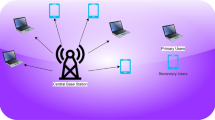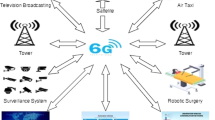Abstract
Relay selection is the key to the Device-to-Device (D2D) cooperative communication. Since idle users often consider their own privacy, security and other self-contained issues such as the energy consumption of their mobile devices, they’re not willing to participate in cooperative communications as relay nodes. In order to encourage idle nodes to participate, an effective reward mechanism is essential. This paper proposes a relay selection algorithm based on price incentive to encourage self-interested idle nodes to participate in relay cooperative communications. Through adopting the Nash negotiation model of gaming theory and introducing utility function, the utility gain of each node is presented and become the standard to strike the bargains between the source node and relay nodes. After that, the appropriate compensation price are obtained, with which each D2D user can gain more benefits while the fairness among users can also be ensured, then the idle user’s intention to cooperate as a relay user in the D2D communication can be enhanced and the terms whether or not to perform relay cooperative communications can be derived. Simulations show that with the appropriate compensation price and the certain terms, the D2D relay selection algorithm based on price incentives is feasible.








Similar content being viewed by others
References
Lee, J., Lee, J. H., et al. (2019). Performance analysis and resource allocation for cooperative D2D communication in cellular networks with multiple D2D pairs. IEEE Communications Letters, 23, 909–912.
Salim, M. M., Wang, D., Liu, Y., et al. (2019). Optimal resource and power allocation with relay selection for RF/RE energy harvesting relay-aided D2D communication. IEEE Access, 7, 89670–89686.
Yu, S., Ejaz, W., Guan, L., et al. (2017). Resource allocation schemes in D2D communications: Overview, classification, and challenges. Wireless Personal Communications, 96, 303–322.
Zhu, X, Wen, S., Wang, C. et al. (2012). A cross-layer study: Information correlation based scheduling scheme for device-to-device radio underlaying cellular networks. In 19th international conference on telecommunications.
Weiwei, Y., Huiyue, Y., Yanjun, H. et al. (2010). D2D communication based on SNR equalization resource allocation algorithm. Computer Engineering, 38(10), 5–8.
Fangjian, L. (2014). Optimal relay selection and power allocation strategy in D2D communication system. Journal of Chongqing University of Posts and Telecommunications: Natural Science Edition, 26(5), 605–610
Lili, W., Hu, R. Q., Qian, Y., et al. (2016). Energy efficiency and spectrum efficiency of multihop device-to-device communications underlaying cellular networks. IEEE Transactions on Vehicular Technology, 65, 367–380.
Xia, W., Shao, S., & Sun, J. (2013). Relay selection strategy for device to device communication. In Information and Communications Technologies (pp. 318–323).
Bofang, F., & Yi, M. (2015). Relay selection and data distribution mechanism in D2D multicast communication scenario. Master thesis. Beijing University of Posts and Telecommunications, pp. 35–38.
Ma, X., Yin, R., Yu, G., et al. (2012). A distributed relay selection method for relay assisted device-to-device communication system. In IEEE personal, indoor and mobile radio communications (pp. 1020–1024).
Gao, C., Zhang, H., Chen, X., et al. (2017). Impact of selfishness in device-to-device communication underlying cellular networks. IEEE Transactions on Vehicular Technology, 66, 9338–9349.
Saraydar, C. U., Mandayam, N. B., & Goodman, D. J. (2001). Pricing and power control in a multicell wireless data network. IEEE Journal on Selected Areas in Communications, 19, 1883–1892.
Zhang, C., Zhao, H., & Jia, M. (2014). A pricing-based cooperation bandwidth allocations algorithm using non-cooperative game theory. In 2014 International Conference on Signal Processing (pp.2379–2384). IEEE.
Borah, S. J., Dhurandher, S. K., Woungang, I., et al. (2017). A game theoretic context-based routing protocol for opportunistic networks in an IoT scenario. Computer Networks, 129, 572–584.
Ji, Z., & Liu, K. J. R. (2008). Multi-stage pricing game for collusion-resistant dynamic spectrum allocation. IEEE Journal on Selected Areas in Communications, 26, 182–191.
Acknowledgment
This work is supported by Science and Technology Project of Shenzhen, China (Grant No. JCYJ20180305124255145), the authors thank to the organization.
Author information
Authors and Affiliations
Corresponding author
Additional information
Publisher's Note
Springer Nature remains neutral with regard to jurisdictional claims in published maps and institutional affiliations.
Rights and permissions
About this article
Cite this article
Li, X., Fang, Z. Relay Selection Based on Price Incentive For Device-to-Device Relay Cooperative Communications. Wireless Pers Commun 114, 467–482 (2020). https://doi.org/10.1007/s11277-020-07372-5
Published:
Issue Date:
DOI: https://doi.org/10.1007/s11277-020-07372-5




